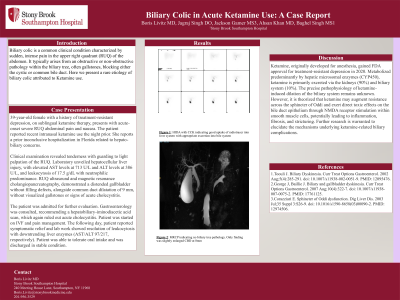Tuesday Poster Session
Category: Biliary/Pancreas
P3562 - Biliary Colic in Acute Ketamine Use: A Case Report
Tuesday, October 29, 2024
10:30 AM - 4:00 PM ET
Location: Exhibit Hall E

Has Audio
- BL
Boris Livitz, MD
Stony Brook Southampton Hospital
Patchogue, NY
Presenting Author(s)
Boris Livitz, MD1, Jagraj Singh, DO1, Jackson Gamer, MS2, Ahsan Khan, MD3, Baghel Singh, MS4
1Stony Brook Southampton Hospital, Southampton, NY; 2Nova Southeastern University, Dr. Kiran C. Patel College of Osteopathic Medicine, Southampton, NY; 3Stony Brook Medicine, Southampton, NY; 4American University of Antigua, Southampton, NY
Introduction: Biliary colic is a common clinical condition characterized by sudden, intense pain in the upper right quadrant (RUQ) of the abdomen. It typically arises from an obstructive or non-obstructive pathology within the biliary tree, often gallstones, blocking either the cystic or common bile duct. Here we present a rare etiology of biliary colic attributed to Ketamine use.
Case Description/Methods: 39-year-old female with a history of treatment-resistant depression, on sublingual ketamine therapy, presents with acute-onset severe RUQ abdominal pain and nausea. The patient reported recent intranasal ketamine use the night prior. She reports a prior inconclusive hospitalization in Florida related to hepato-biliary concerns.
Clinical examination revealed tenderness with guarding to light palpation of the RUQ. Laboratory unveiled hepatocellular liver injury, with elevated AST levels at 713 U/L and ALT levels at 386 U/L, and leukocytosis of 17.5 g/dL with neutrophilic predominance. RUQ ultrasound and magnetic resonance cholangiopancreatography, demonstrated a distended gallbladder without filling defects, alongside common duct dilatation of 9 mm, without visualized gallstones or signs of acute cholecystitis.
The patient was admitted for further evaluation. Gastroenterology was consulted, recommending a hepatobiliary-iminodiacetic acid scan, which again ruled out acute cholecystitis. Patient was started on IVF and pain management. The following day, patient reported symptomatic relief and lab work showed resolution of leukocytosis with downtrending liver enzymes (AST/ALT 97/217, respectively). Patient was able to tolerate oral intake and was discharged in stable condition.
Discussion: Ketamine, originally developed for anesthesia, gained FDA approval for treatment-resistant depression in 2020. Metabolized predominantly by hepatic microsomal enzymes (CYP450), ketamine is primarily excreted via the kidneys (90%) and biliary system (10%). The precise pathophysiology of ketamine-induced dilation of the biliary system remains unknown. However, it is theorized that ketamine may augment resistance across the sphincter of Oddi and exert direct toxic effects on the bile duct epithelium through NMDA receptor stimulation within smooth muscle cells, potentially leading to inflammation, fibrosis, and stricturing. Further research is warranted to elucidate the mechanisms underlying ketamine-related biliary complications.
Disclosures:
Boris Livitz, MD1, Jagraj Singh, DO1, Jackson Gamer, MS2, Ahsan Khan, MD3, Baghel Singh, MS4. P3562 - Biliary Colic in Acute Ketamine Use: A Case Report, ACG 2024 Annual Scientific Meeting Abstracts. Philadelphia, PA: American College of Gastroenterology.
1Stony Brook Southampton Hospital, Southampton, NY; 2Nova Southeastern University, Dr. Kiran C. Patel College of Osteopathic Medicine, Southampton, NY; 3Stony Brook Medicine, Southampton, NY; 4American University of Antigua, Southampton, NY
Introduction: Biliary colic is a common clinical condition characterized by sudden, intense pain in the upper right quadrant (RUQ) of the abdomen. It typically arises from an obstructive or non-obstructive pathology within the biliary tree, often gallstones, blocking either the cystic or common bile duct. Here we present a rare etiology of biliary colic attributed to Ketamine use.
Case Description/Methods: 39-year-old female with a history of treatment-resistant depression, on sublingual ketamine therapy, presents with acute-onset severe RUQ abdominal pain and nausea. The patient reported recent intranasal ketamine use the night prior. She reports a prior inconclusive hospitalization in Florida related to hepato-biliary concerns.
Clinical examination revealed tenderness with guarding to light palpation of the RUQ. Laboratory unveiled hepatocellular liver injury, with elevated AST levels at 713 U/L and ALT levels at 386 U/L, and leukocytosis of 17.5 g/dL with neutrophilic predominance. RUQ ultrasound and magnetic resonance cholangiopancreatography, demonstrated a distended gallbladder without filling defects, alongside common duct dilatation of 9 mm, without visualized gallstones or signs of acute cholecystitis.
The patient was admitted for further evaluation. Gastroenterology was consulted, recommending a hepatobiliary-iminodiacetic acid scan, which again ruled out acute cholecystitis. Patient was started on IVF and pain management. The following day, patient reported symptomatic relief and lab work showed resolution of leukocytosis with downtrending liver enzymes (AST/ALT 97/217, respectively). Patient was able to tolerate oral intake and was discharged in stable condition.
Discussion: Ketamine, originally developed for anesthesia, gained FDA approval for treatment-resistant depression in 2020. Metabolized predominantly by hepatic microsomal enzymes (CYP450), ketamine is primarily excreted via the kidneys (90%) and biliary system (10%). The precise pathophysiology of ketamine-induced dilation of the biliary system remains unknown. However, it is theorized that ketamine may augment resistance across the sphincter of Oddi and exert direct toxic effects on the bile duct epithelium through NMDA receptor stimulation within smooth muscle cells, potentially leading to inflammation, fibrosis, and stricturing. Further research is warranted to elucidate the mechanisms underlying ketamine-related biliary complications.
Disclosures:
Boris Livitz indicated no relevant financial relationships.
Jagraj Singh indicated no relevant financial relationships.
Jackson Gamer indicated no relevant financial relationships.
Ahsan Khan indicated no relevant financial relationships.
Baghel Singh indicated no relevant financial relationships.
Boris Livitz, MD1, Jagraj Singh, DO1, Jackson Gamer, MS2, Ahsan Khan, MD3, Baghel Singh, MS4. P3562 - Biliary Colic in Acute Ketamine Use: A Case Report, ACG 2024 Annual Scientific Meeting Abstracts. Philadelphia, PA: American College of Gastroenterology.
